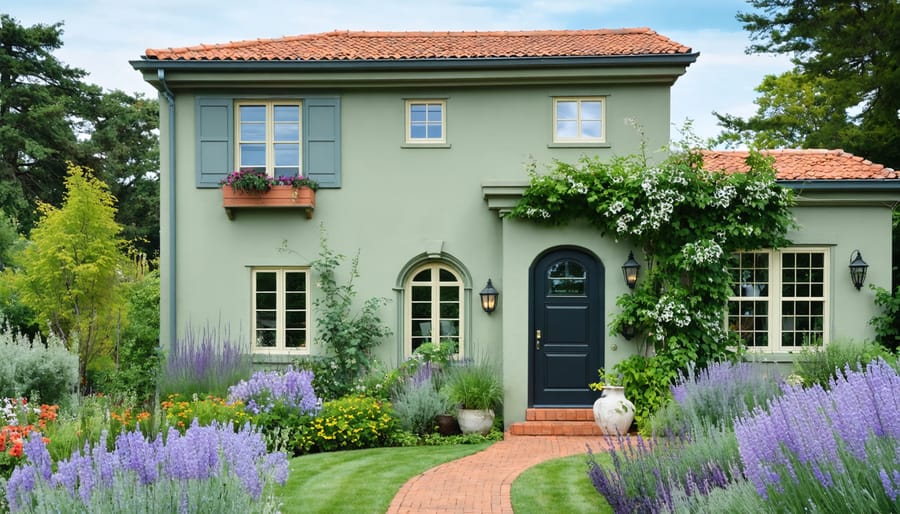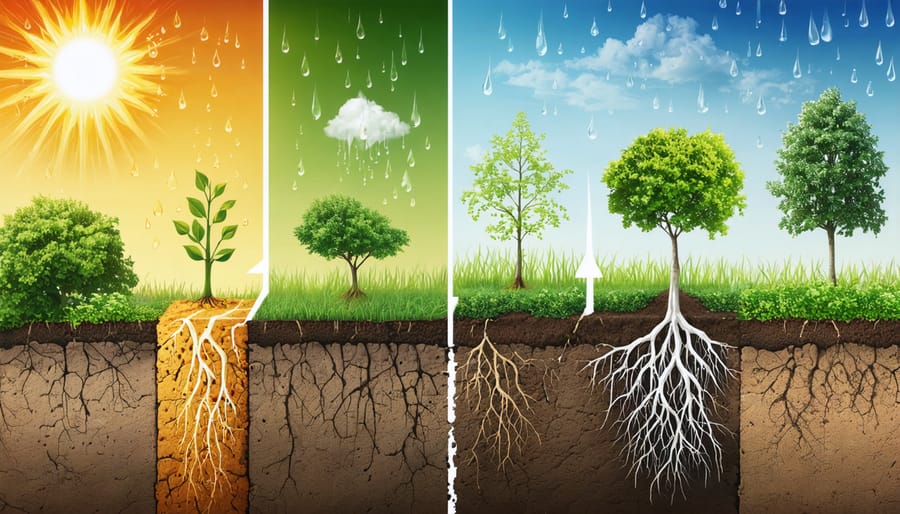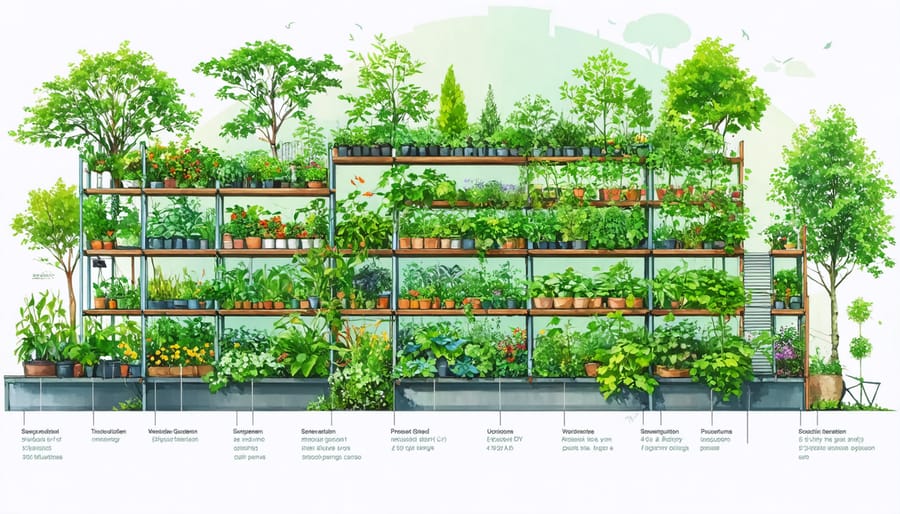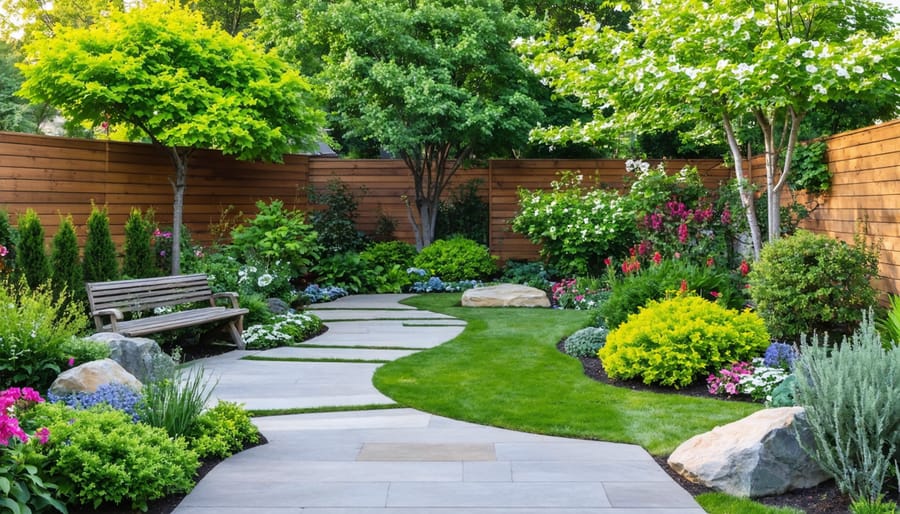Transform your home’s exterior into a stunning garden backdrop by partnering with Toronto Home Painters who understand the delicate balance between architecture and nature. Choose paint colors that echo your garden’s natural palette – soft sage greens complement flowering perennials, while warm terra cotta tones create a Mediterranean aesthetic that pairs beautifully with drought-resistant plants. Consider your garden’s seasonal changes when selecting exterior colors, ensuring your home remains visually striking whether surrounded by spring blooms or autumn foliage.
Paint your home’s trim in colors that draw attention to architectural features while creating natural frames for climbing vines and vertical gardens. Deep forest greens or rich earth tones ground your home in its landscape, while lighter shades lift the eye upward, making both your home and garden appear larger and more integrated. The right color combination doesn’t just beautify your home – it creates an outdoor sanctuary where architecture and nature flow seamlessly together.
This thoughtful approach to exterior painting transforms your garden from a simple outdoor space into an extension of your home’s personality, creating a cohesive, welcoming environment that enhances both your property’s value and your daily enjoyment of outdoor living.
How Exterior Paint Colors Impact Your Garden’s Visual Appeal
Creating Color Harmony with Plants
Creating a harmonious blend between your home’s exterior paint and your garden starts with understanding basic color schemes for garden design. Look to your existing plants for inspiration – if you have purple lavender or blue hydrangeas, consider warm beige or soft gray tones that will make these flowers pop. For gardens with lots of yellow and orange blooms, slate blues and cool grays create a beautiful contrast that draws the eye.
Take note of your garden’s seasonal changes too. Those bright spring tulips and summer roses might give way to russet autumn leaves, so choose a paint color that works year-round. Green foliage is your constant companion, making it a reliable reference point for color selection.
Consider the natural light in your garden space. South-facing gardens with bright sunlight can handle deeper paint colors, while shadier spots might benefit from lighter shades that help brighten the space. Remember, white trim can create a lovely frame for climbing vines and trailing plants, making them stand out beautifully against your home’s exterior.

Using Paint to Frame Natural Features
Paint can be a powerful tool for drawing attention to your garden’s most striking features. By strategically selecting paint colors for walls, fences, or architectural elements near your garden, you can create stunning frames that highlight your favorite plants and landscaping elements.
Consider painting a backdrop wall in a deep green or navy blue to make vibrant flowers pop, or choose a warm terracotta shade to complement Mediterranean-style plantings. For modern gardens, crisp white paint can create a gallery-like setting that makes foliage stand out dramatically.
When framing natural features, remember that less is often more. Instead of painting entire sections, try creating focal points by painting single elements like arbors, trellises, or garden gates. These painted features can guide the eye toward prized plants or garden vignettes.
Match your paint choices to your garden’s color scheme during peak blooming seasons. For year-round appeal, select neutral tones that work well with your garden’s changing palette throughout the seasons. Remember to use weather-resistant exterior paints that will maintain their appearance while protecting the surfaces underneath.

Best Paint Colors for Different Garden Styles
Cottage Garden Combinations
For cottage gardens bursting with informal charm, choose paint colors that enhance rather than compete with your blooming beauties. Soft, muted shades like dusty rose, sage green, and buttery cream create a romantic backdrop that lets your flowers take center stage. Consider pale lavender or robin’s egg blue for window frames and doors, echoing the natural colors found in traditional cottage garden flowers.
Weathered whites and warm grays work beautifully with climbing roses and flowering vines, while earthy terracotta tones complement the natural stone paths and rustic elements common in cottage gardens. For trim and architectural details, gentle pastels like shell pink or seafoam green add whimsical touches without overwhelming the garden’s natural beauty.
Remember that cottage gardens change dramatically through the seasons, so select paint colors that will look harmonious whether your garden is in full summer bloom or showing off its autumn colors. A slightly distressed or weathered finish can add to the casual, lived-in charm that cottage gardens are known for.
Modern Landscape Pairings
Contemporary garden designs call for thoughtful color pairings that reflect modern sensibilities. Minimalist landscapes shine when paired with crisp whites and warm grays, creating a sophisticated backdrop for architectural plants and clean-lined features. For a bold statement, deep charcoal exteriors make green foliage pop while providing a dramatic canvas for ornamental grasses and sculptural succulents.
Natural earth tones like warm taupe and soft sage complement sustainable garden designs featuring native plants and water-wise landscaping. These colors create a seamless transition between your home and the surrounding environment. For those embracing the indoor-outdoor living trend, soft blues and gentle greens echo the colors of drought-resistant Mediterranean plants while maintaining a modern edge.
Consider pairing cool-toned grays with vibrant accent colors on doors or trim to add personality without overwhelming your garden’s natural beauty. Metallic finishes like brushed silver or copper can introduce subtle shimmer that catches light and complements both hardscaping elements and modern water features.
Mediterranean Garden Palettes
Mediterranean gardens evoke the sun-drenched landscapes of Southern Europe, and choosing the right paint colors can enhance their warm, inviting appeal. Soft whites and creamy off-whites provide a perfect backdrop for drought-resistant plants, allowing the silvery foliage of lavender and olive trees to shine. These neutral tones also reflect sunlight, helping to keep your home cooler during hot summer months.
Terracotta oranges and warm ochre yellows echo the earthen pots and sun-baked walls typical of Mediterranean landscapes, creating a cohesive look with your garden’s hardscaping. These colors pair beautifully with the purple blooms of rosemary and sage, as well as the bright pops of bougainvillea.
For trim and accent colors, consider deep Mediterranean blues that complement both the sky and water features, or sage greens that mirror the natural foliage of herbs and native plants. These colors work particularly well with stone pathways and gravel gardens, creating a seamless transition between your home’s exterior and the surrounding landscape.
Remember to test your chosen colors in different lighting conditions, as Mediterranean gardens often feature strong sunlight that can intensify paint hues throughout the day.
Practical Considerations for Garden-Friendly Paint Selection
Weather-Resistant Finishes
When it comes to protecting your home’s exterior in a garden setting, choosing the right weather-resistant finish is crucial. Like other weather-resistant garden solutions, your paint needs to stand up to moisture, sun exposure, and varying temperatures while maintaining its beauty.
For areas close to plants and flowers, opt for high-quality acrylic latex exterior paints. These paints create a flexible barrier that resists cracking and peeling, even when exposed to regular garden watering. They’re also excellent at preventing mildew growth, a common concern in lush garden environments.
Consider using paint with built-in UV protection to prevent fading, especially in sunny garden spots. Many modern exterior paints now include specialized polymers that reflect sunlight and maintain color integrity for years. For areas that might experience frequent contact with climbing plants or trailing vines, choose paints with enhanced scratch resistance and a satin or semi-gloss finish – these are easier to clean and more durable than flat finishes.
Remember to prepare surfaces thoroughly before painting, paying special attention to areas near irrigation systems or spots where moisture tends to collect. A proper primer specific to your surface material will ensure the best possible adhesion and longevity of your finish.
Eco-Friendly Paint Options
When it comes to eco-friendly paint options, there are several excellent choices that protect both your garden and the environment. Natural mineral-based paints offer outstanding durability while being completely safe for nearby plants and soil. These paints are free from volatile organic compounds (VOCs) and contain ingredients like clay, lime, and natural pigments.
Water-based acrylic paints with low VOC content are another garden-friendly option. They’re particularly good for wooden features like fences and trellises, as they allow the wood to breathe while providing excellent protection against weather elements. Look for paints carrying environmental certifications such as Green Seal or ECOLOGO.
Milk paint, made from milk protein, lime, and natural pigments, is perfect for garden furniture and decorative elements. It’s completely biodegradable and safe for plants, plus it develops a beautiful, authentic patina over time. For metal surfaces, consider using powder coating – it’s durable, doesn’t release harmful chemicals, and creates minimal waste during application.
Remember to properly dispose of any leftover paint through local recycling programs to maintain your garden’s eco-friendly status.
Garden Features to Consider When Painting
Coordinating with Hardscaping
When coordinating your home’s paint colors with existing hardscaping elements, think of your garden as a cohesive outdoor room where every element should work together harmoniously. Start by examining the dominant colors in your pathways, retaining walls, and other permanent structures. For instance, if you have a brick pathway with warm reddish-brown tones, consider paint colors that complement these earthy hues, such as soft sage green or warm beige.
Natural stone features often contain multiple color variations that can inspire your paint choices. Take a close look at your stonework in different lighting conditions and identify the undertones – they might reveal subtle grays, tans, or even hints of blue that could guide your color selection.
For modern gardens with concrete elements, consider how different paint colors can either soften or enhance the industrial feel. Cool grays and crisp whites can create a contemporary look, while warmer neutrals can help concrete features blend more naturally with the landscape.
Don’t forget about garden structures like pergolas, arbors, and fences. These elements can serve as transitional pieces between your home’s main color and your hardscaping. Consider painting them in a coordinating shade that ties everything together, or use them to introduce subtle accent colors that complement both your home’s exterior and existing hardscape materials.
Remember that lighting will affect how colors appear throughout the day, so test paint samples near your hardscaping elements at different times to ensure a pleasing match in all conditions.
Seasonal Color Changes
When choosing exterior paint colors for your home, it’s essential to consider how seasonal color changes in gardens will affect the overall appearance of your property throughout the year. Your garden’s palette shifts dramatically from spring’s vibrant blooms to autumn’s warm hues, and your house color should harmonize with these natural transitions.
Consider selecting a neutral base color that serves as a versatile backdrop for your changing landscape. Warm grays, soft taupes, and muted sage greens work beautifully year-round, allowing your garden’s colors to take center stage in every season. These choices provide enough visual interest without competing with your plantings.
For trim and accent colors, think about your garden’s most consistent elements. If you have evergreen shrubs, choosing deeper green or bronze accents can create a cohesive look that ties your home to the landscape. Similarly, if you maintain flowering perennials in specific colors, you might echo these hues in subtle ways through your paint choices.
Remember that strong sunlight can make colors appear brighter, while shade tends to darken them. Test paint samples in different areas around your home and observe them throughout the day and in various weather conditions. This approach ensures your chosen colors will complement your garden beautifully, regardless of the season or lighting conditions.

As we’ve explored throughout this article, the relationship between your home’s exterior paint and your garden is a delicate dance of color, contrast, and harmony. By carefully considering your garden’s existing palette, seasonal changes, and overall design aesthetic, you can create a stunning visual connection between your living space and the natural world around it.
Remember that choosing the right paint colors isn’t just about current trends or personal preferences – it’s about creating a lasting impression that will enhance your garden’s beauty throughout the years. Whether you’ve opted for subtle earth tones that let your flowers take center stage, or bold accent colors that complement your foliage, your thoughtful color choices will contribute to a more cohesive and inviting outdoor space.
Before you begin your next exterior painting project, take time to observe your garden through the seasons. Consider how different lighting conditions affect color perception and how your chosen palette will interact with your landscape’s changing faces. Don’t forget practical considerations like maintenance and durability – your paint choice should not only look beautiful but also stand up to the elements.
By treating your home’s exterior as an integral part of your garden design, you’ll create a more harmonious and enjoyable outdoor environment. So grab those paint swatches, spend time in your garden, and let nature inspire your color choices. The result will be a home that truly belongs in its landscape, creating a picture-perfect setting for years of gardening pleasure.




